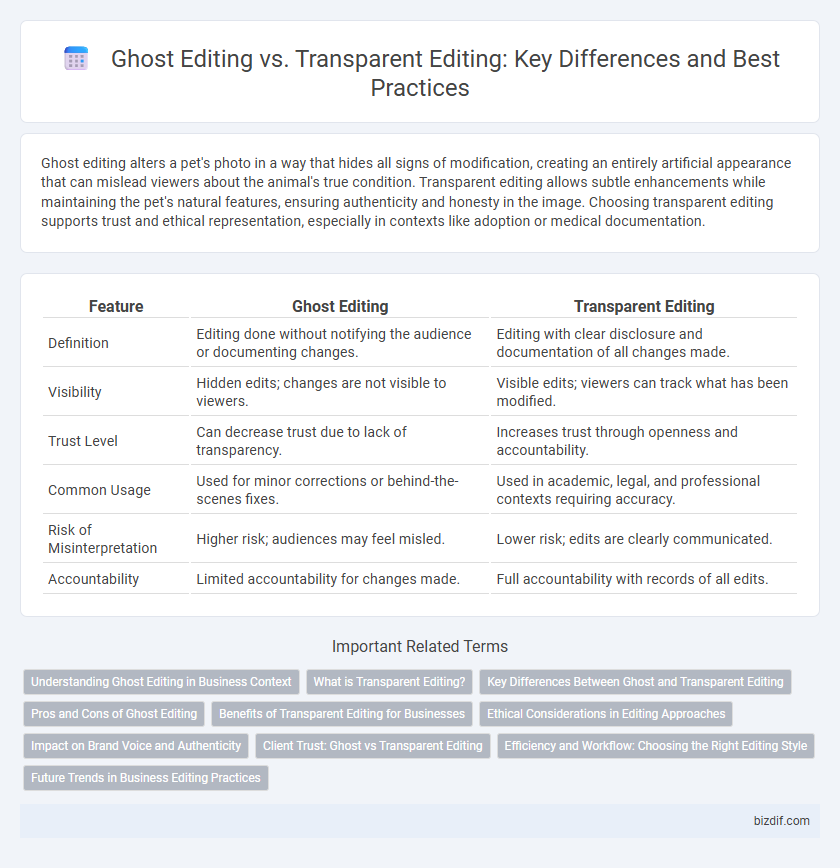Ghost editing alters a pet's photo in a way that hides all signs of modification, creating an entirely artificial appearance that can mislead viewers about the animal's true condition. Transparent editing allows subtle enhancements while maintaining the pet's natural features, ensuring authenticity and honesty in the image. Choosing transparent editing supports trust and ethical representation, especially in contexts like adoption or medical documentation.
Table of Comparison
| Feature | Ghost Editing | Transparent Editing |
|---|---|---|
| Definition | Editing done without notifying the audience or documenting changes. | Editing with clear disclosure and documentation of all changes made. |
| Visibility | Hidden edits; changes are not visible to viewers. | Visible edits; viewers can track what has been modified. |
| Trust Level | Can decrease trust due to lack of transparency. | Increases trust through openness and accountability. |
| Common Usage | Used for minor corrections or behind-the-scenes fixes. | Used in academic, legal, and professional contexts requiring accuracy. |
| Risk of Misinterpretation | Higher risk; audiences may feel misled. | Lower risk; edits are clearly communicated. |
| Accountability | Limited accountability for changes made. | Full accountability with records of all edits. |
Understanding Ghost Editing in Business Context
Ghost editing in a business context involves subtle, behind-the-scenes modifications to content without overt acknowledgment, enhancing clarity and coherence while preserving the original author's voice. This approach is particularly valuable in corporate communications, marketing materials, and executive publications where maintaining brand consistency and messaging accuracy is critical. Effective ghost editing requires a deep understanding of the business's goals, target audience, and tone to ensure seamless integration of edits that support strategic objectives.
What is Transparent Editing?
Transparent editing refers to the process of revising a text while maintaining clear visibility of all changes made, ensuring that edits are easily identifiable to readers or collaborators. This approach allows for open tracking of modifications, preserving the original content alongside the adjustments for comparison. Transparent editing enhances accountability and facilitates collaborative review by documenting every alteration explicitly.
Key Differences Between Ghost and Transparent Editing
Ghost editing involves making changes to a text without indicating any modifications, preserving the original author's voice as if untouched. Transparent editing clearly marks all revisions, enabling readers to track every addition, deletion, or correction made to the content. Key differences include visibility of changes, with ghost editing prioritizing seamless integration while transparent editing ensures full disclosure of adjustments.
Pros and Cons of Ghost Editing
Ghost editing ensures the original content remains authentic and unaltered, preserving the creator's unique voice and style. However, the lack of visible corrections can lead to confusion or misunderstandings for collaborators who rely on transparent feedback. This method is efficient for quick fixes but may reduce opportunities for learning and improvement during the editing process.
Benefits of Transparent Editing for Businesses
Transparent editing enhances brand credibility by ensuring all modifications are visible and justifiable, fostering trust among clients and stakeholders. Businesses benefit from improved accountability and collaborative workflow when editors openly track changes, leading to higher-quality content and streamlined revision processes. This approach also mitigates risks related to miscommunication and content integrity, supporting consistent messaging across platforms.
Ethical Considerations in Editing Approaches
Ghost editing raises significant ethical concerns due to the lack of transparency, potentially misleading readers about the authenticity of the content. Transparent editing promotes trust and accountability by clearly disclosing changes, ensuring that the author's original intent is respected and preserved. Ethical editing practices prioritize honesty, authorial consent, and maintaining the integrity of the text throughout the revision process.
Impact on Brand Voice and Authenticity
Ghost editing subtly refines content without altering the original author's voice, preserving the brand's authenticity and consistent tone. Transparent editing involves openly acknowledging revisions, which can enhance trust but risks diluting the brand voice if overused. Maintaining a balance between precise edits and retaining genuine expression is crucial for sustaining brand credibility and audience engagement.
Client Trust: Ghost vs Transparent Editing
Ghost editing preserves the original content's integrity by making invisible changes, fostering client trust through subtle enhancement without overtly altering the author's voice. Transparent editing involves openly communicating all changes, which builds trust by ensuring clients are fully aware of alterations and can provide feedback. Both approaches impact client trust differently, with ghost editing valuing seamless refinement and transparent editing emphasizing open collaboration.
Efficiency and Workflow: Choosing the Right Editing Style
Ghost editing streamlines the workflow by making seamless corrections without altering the original structure, enhancing efficiency for projects requiring rapid turnaround. Transparent editing involves clearly marked changes, allowing for collaborative review and iterative improvements, which benefits complex projects with multiple stakeholders. Selecting the right editing style depends on the balance between speed and the need for detailed feedback in the editorial process.
Future Trends in Business Editing Practices
Future trends in business editing practices emphasize the rise of transparent editing, where changes are clearly documented to maintain authenticity and build trust with stakeholders. Emerging AI-driven tools enable real-time collaboration and seamless integration of transparent edits, enhancing efficiency and accuracy. Companies increasingly prioritize transparent editing to support compliance, foster accountability, and improve communication in a data-driven business environment.
Ghost Editing vs Transparent Editing Infographic

 bizdif.com
bizdif.com